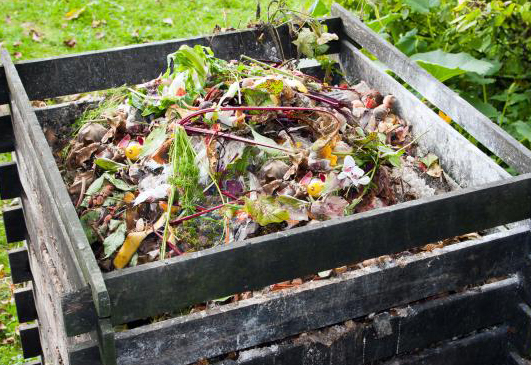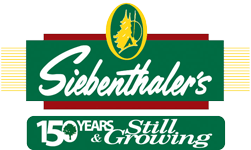
COMPOST HAPPENS…
WITH A LITTLE HELP FROM YOU!

Composting is the decomposition of plant remains and other once-living materials to make an earthy, dark, crumbly substance that is excellent for adding to houseplants or enriching soil. www.howtocompost.org
Composting is an excellent way to avoid both wasting useful, natural resources and creating environmental problems, while at the same time producing a high quality and inexpensive soil amendment.
According to the US EPA, yard trimmings and food residuals together constitute 24% of the U.S. municipal solid waste stream.
Composting occurs quickly or slowly, depending on the process used. A pile of organic waste will decompose slowly if unattended. Composting can be completed in 2-6 weeks with a little help from you. There are 3 key elements 1) aeration – turning the compost pile, 2) moisture, and 3) the proper carbon to nitrogen ratio. The breakdown of organic waste occurs when carbon provides the food or energy source that ingests nitrogen for protein synthesis. Leaves are a great source of carbon, while fresh grass clippings and manure are good sources of nitrogen. A good rule of thumb is 100 lbs of carbon for every 3-4 lbs of nitrogen. If too much nitrogen is added unpleasant odors can occur.
What Goes In |
What Stays Out and Why |
|
Animal manure |
Black walnut tree leaves or twigs Coal or charcoal ash Dairy products (butter, egg yolks, milk, sour cream, yogurt) Diseased or insect-ridden plants Fats, grease, lard, or oils Meat or fish bones and scraps Pet wastes (e.g., dog or cat feces, soiled cat litter) Yard trimmings treated with chemical pesticides |
Building a Compost Structure
Select the right structure for you. While there are many types of manufactured structures available consider building one yourself. The objective is to hold compostable material in a enclosed mass that is about 3′ to 5′ in each direction. Smaller sizes may not develop enough heat and larger sizes may not allow adequate air and water flow. The structure can be built from cement blocks, brick, wood or other materials. Wood should be rot resistant such as redwood, cedar or pressure treated with a wood preservative. Timbers treated with creosote or pentachlorophenol should be avoided. Some options are shown below.
| Cement blocks or bricks. Lay them without mortar, leaving spaces between blocks to permit aeration. Build a 3-sided, square, or 3-bin unit. Loosely stacked blocks or bricks may make this structure an inappropriate choice if located near areas where children play. | Wire fence or snow fence. Multiply the diameter you want by 3.14 to determine the length of fence needed. Fasten wire with chain clips. To turn the pile, peel the fence away and set it up nearby. Turn compost into the structure in its new location. |
| A barrel composter can be built from a 55 gallon drum. Drill 6-9 rows of 1/2″ holes over the length of the barrel to let air circulate. Fill ¾ full of material. Every few days lay it down and roll it over a few times to mix. Use a barrel that has not been used for toxic substances. | Portable Wood & Wire is very flexible. Works well in small spaces for yard wastes or a portable turning unit for kitchen and yard waste. Can be easily moved to turn piles or build a new one: Simply undo the latches, pull the sides apart and move it. |
| 3 Bin Compost Bin is very efficient and durable structure for fast composting. It holds a considerable amount of compost and allows good air circulation. This works on an assembly line idea, having 3 batches of compost in varying stages of decomposition. The compost material is started in the 1st bin and allowed to heat up for 3 to 5 weeks. The 2nd for another 4 to 7 weeks, while new batch of material is started in the 1st bin. The material in the middle bin is turned into the last bin as finished compost. | Short on time??? There are also composting bins for purchase. Many bins are made from recycled plastic. A few examples are the compost tumbler bins, 5 garden tray compost bins and premade wire composting bins. We would be happy to answer any of your questions whether you are building or purchasing your composting bin. |

